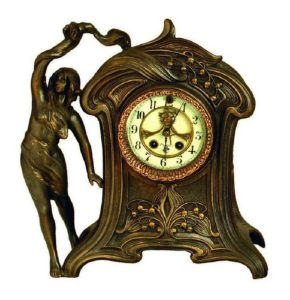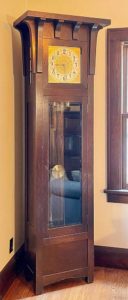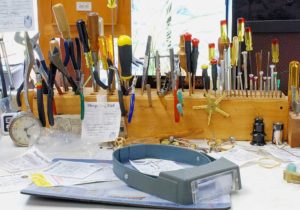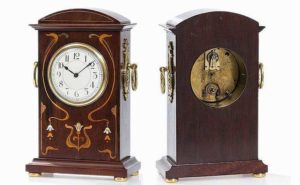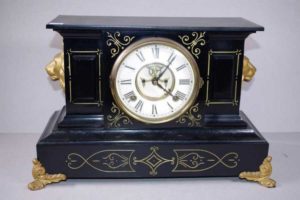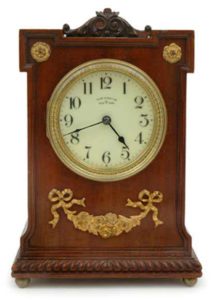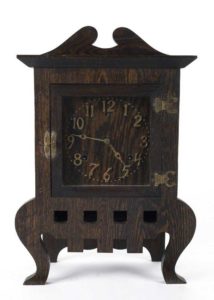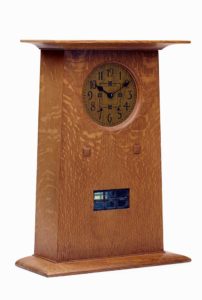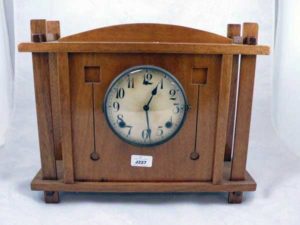Small Home Gazette, Summer 2021
Maintaining and Repairing Your Old Clocks
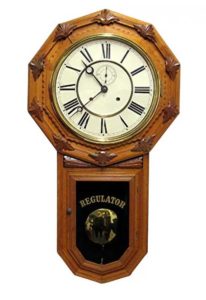
Seth Thomas “Regulator” clock. A regulator clock was a wall-mounted, weight-driven clock regulated by a swinging pendulum and more accurate than a spring-wound clock.
Keeping track of time seems to be part of our biology. We monitor it more closely than anything else by surrounding ourselves with devices that keep us up to the minute. In the decades before the Arts & Crafts era, there was tremendous innovation and industrialization that made timepieces available to nearly everyone. By the turn of the 20th century, a clock was a key part of making a house a home, and some were already considered antiques.
Today, favorite timepieces in many households were inherited or were memorable purchases. Memories of the people and experience give the clock added value. Few things contribute more strongly to the cozy ambiance of an American bungalow than the gentle ticktock of a pendulum clock or the reassuring sound of an hourly chime.
If you are now thinking of a favorite antique clock in your bungalow, when was the last time you had that treasure serviced? For me, the answer is—never. To correct that lapse, I surfed the Internet and asked a few Twin Cities Bungalow Club members for names of local antique clock repair shops. Some of the shops recommended other colleagues. As with so many of my projects, my search became the basis for this article.
A History of Timekeeping
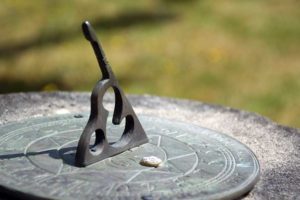 Humans have been struggling to keep track of time for thousands of years. Egyptian obelisks, which appeared about 3,500 B.C., were an early effort to track time. These gave way to more sophisticated sundials. The Greeks later developed water clocks; the Chinese used candle clocks to track time at night; and the needs of sea mariners and religious figures drove further innovation.
Humans have been struggling to keep track of time for thousands of years. Egyptian obelisks, which appeared about 3,500 B.C., were an early effort to track time. These gave way to more sophisticated sundials. The Greeks later developed water clocks; the Chinese used candle clocks to track time at night; and the needs of sea mariners and religious figures drove further innovation.
By the early 20th century, the wristwatch was already 400 years old; the pendulum clock was 250; and the mechanical alarm clock was a relative youngster at just over 100 years old. The Arts & Crafts era saw the first battery-powered clock—produced by the Warren Clock Company in Massachusetts. Unfortunately, the batteries of that era were unreliable and the company turned its attention to electric motors to power its clocks. Prior to this, all clocks were either powered by wound springs or by weights.
With millions of spring- and weight-driven clocks in use, the availability of service and repair shops was robust. Parts were in good supply, and clock repair was a secure and valued profession. Today, clock repair is a niche field; parts are scarce or unavailable; and there is not enough consumer demand to support more than a handful of shops in any community—even in a metro area like the Twin Cities. If all of us spent a little more on maintaining our antique clocks, the clock repair business will stand a better chance of surviving.
Myths and Misunderstandings
All antique clocks will need both minor maintenance and a major overhaul at some point in their lives. Our actions, or lack thereof, can delay or hasten inevitable repairs. These actions are sometimes rooted in myths and misunderstandings.
A chief myth about clock repair is that they do not need regular maintenance. “If it ain’t broke, don’t fix it” is a philosophy that, when it comes to old clocks, will eventually result in a broken clock. How often you should service your weight- and spring-driven clock depends on several factors. How dusty is your house? Do you have ventilation fans that remove humidity and cooking-related particles from your indoor air? Does the clock sit above a heat source that might dry it out or near a sunny window? Answers to these and other questions will help determine whether your clocks need frequent or occasional service.
Another point of confusion is the need to oil your antique clock’s movement. Too much oil will serve as a magnet for dust and dirt, which can lead to excessive wear. A clock will tell you when it needs oil by stopping frequently or struggling to chime. Most experts appear to agree that three to five years is a good rule of thumb, but the environmental conditions noted above may require a different cycle. Also, keep WD-40 out of your clocks since it dries rather than lubricates.
If you want to do your own oiling, be prepared to spend a bit of money on buying good quality oils—different oils for different parts of the clock. And know that it is wise to do your research before attempting to pull the movement out of the case for easier access to the parts that need oiling.
There is also a misunderstanding that old clocks should be accurate, down-to-the-second timekeepers. The precision of our modern timepieces has us applying the same standard to all clocks. Some owners of antique clocks return to the shop with complaints that the clock still does not keep perfect time. Antique clock repair experts advise that we enjoy the moment when two or more antique clocks happen to chime together.
There is a misconception that you should never move the hands backward on an antique clock to reset the time. It is actually okay to do this on many old clocks. Clocks made after 1920 are more likely to allow you to move the hands backward. But if you feel any resistance, turn the hands clockwise, and be sure to stop at each of the clock’s chiming points—quarter hour, half hour, or hour—to allow the chime to keep up with your adjustment.
For grandfather clocks and others powered by weights, there is a belief that one should hold the weights during winding to remove tension on the chain. If you think about it logically, there is no more strain on the chain during winding than during normal running. You can avoid the potential for disconnecting the weights or chain by letting them hang as you wind. Just remember to stop short so that the top of the weights remain at least two inches below the movement.
Perhaps the most common myth reported by clock repair people is that a spring-driven clock can be wound too tight. While it is possible, the amount of force required to break the mainspring is substantial. Consequently, many owners avoid fully tightening the spring and then seek maintenance when their antique clock fails to run as long as they think it should between windings. With practice, you can develop a “feel” for when you are nearing the end point of winding the springs.
Shopping for Service
How much should you spend on maintaining your antique clock? Even the cost of routine maintenance can exceed a clock’s market value. But an old clock’s value may also be measured in terms of family history, beauty, and its contribution to your bungalow’s aesthetic quality.
I contacted 17 Twin Cities-area clock repair companies. Their contact information is below. Unfortunately, only five responded to the survey I sent, so the following is based on a small number of businesses.
- Most shops will provide a written estimate before starting work. They will need to see the clock in person before preparing an estimate.
- Expect to pay a down payment. This is more likely if expensive replacement parts need to be ordered.
- Those businesses that repair large clocks will come to your home to do so. Expect to pay for transporting parts of your grandfather clock to their shop and for returning to reinstall them after repair. You will need to transport smaller clocks to and from the shop.
- Call ahead before dropping off a clock since your clock repair expert might be out on a service call.
- Turnaround time can vary widely. I described a scenario of “a 1920s-era mantel clock that keeps time but has not seen maintenance in years.” The survey respondents quoted anywhere from a week to eight months for this type of repair.
- Similarly, the cost estimate for a poorly maintained, 1920s-era mantel clock was highly variable—ranging from $65 for a simple lubrication to $550 for a more involved tune-up. “It depends” is perhaps the best answer I can give based on the surveys.
- None of the respondents offer appraisal services for antique clocks. But they agreed that the scarcity or rareness of a clock is the most important factor in determining value; followed by brand or maker; and then by condition of the face, the case, and the movement.
For me, our antique clocks feel like part of the family. Not all of them run—one from my Mom has a tragic history of DIY repair. The clocks add ambience to our bungalow. It is time for me to help ours survive a bit longer.
Local Antique Clock Repair Companies
Businesses that responded to my survey:
- Ashland Hollow Clock
Fred Weiland
Hastings, MN
651-438-2615
ashlandhollow.com - Blackstone Manor Clock Repair
Mark Purdy
815 Mainstreet, Hopkins, MN
952-920-1300
blackstonemanorclockrepair.com -
Edina Clock Repair Inc.
Richard Zielike
5720 Lois Lane, Edina, MN
952-983-0681 (shop), 612-860-6120 (mobile)
edinaclock.com - Susan Wood Studio
5417 45th Ave. S., Minneapolis
612-727-1300
anvilclock@gmail.com - Timeless Jewelry & Clocks
3496 Shoreline Drive, Suite 2c, Wayzata, MN
952-471-1244
timelessjewelryandclocks.com
Businesses I contacted, but did not respond:
- Antique Clock & Watch Restoration
763-595-8678 - Antique Clockworks Ltd., Minneapolis
antiqueclockworksltd.com - Clock Depot
clockdepot.com - Clock Shop, Anoka, MN
763-576-1935 - Curt’s Clocks
curtsclocks.com - Expert Clock Repair & Sales
715-262-570 - House of Clocks – St. Paul
houseofclocksmn.com - It’s About Time
itsabouttimeclockshop.com -
Jim’s Clock Services & Repair
Jims-clock-services-repair.business.site - Ogren & Trigg Clock Services
612-377-2290
Contacted, but no longer repairing antique clocks:
- The Fixery, St. Paul
651-690-5524
yelp.com/biz/the-fixery-saint-paul
This company is focused on watch repair, citing a lack of parts and trained workers as reasons for exiting the antique clock repair market. - Antique Clock Doc Repair & Sales, Elk River, MN
Owner retired on July 31, 2021.
Resources
“The Development of Clocks and Watches Over Time,” by Mary Bellis. ThoughtCo.
For general FAQs about antique clock repair, visit these sites:
- “Clock Repair FAQ”
Edina Clock Repair, Inc. - “Caring for Your Antique Clock”
Old House Online - “Clock Myths”
Master Clock Repair
For a discussion of which oils are best for antique clock movements, download the pdf “A Tale of Clock Oils.”









